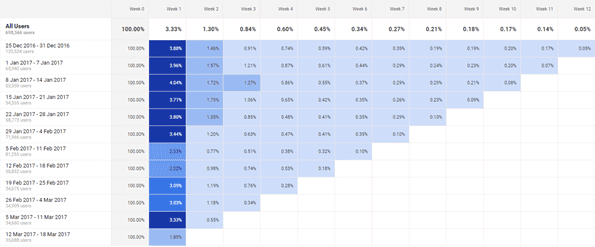Customer Retention Strategies Using Cohort Analysis
Consumer buying behaviour has certainly been changing over the years and us Marketers are often challenged to rethink ‘best practice’ and ‘what’s worked in the past’ because it’s no longer relevant. This is not only the case for ‘new customer acquisition’ but also for ‘return customer acquisition’ and whilst brand loyalty seems more feeble than ever, we really need to think long and hard about how we can capture any loyalty available to us.
To market a brand, whatever the industry, you need to understand the audience you’re marketing to. Ultimately, they are the ones with the intent to ‘buy’ (at some point) and our job is to ensure our client(s) are there to be seen when those consumer finger tips are itching to make a purchase, usually within search results pages be that organically or via paid media methods. Now with Brexit to be negotiated, following a successful 2016 for sales, consumer confidence is likely to change buying habits once again.
Make an Offer and the Sales Will Come

We’ve already adapted to a promotion led consumer in all of retail, particularly in eCommerce given that in 2015 it was reported that 50% of consumers only make an online purchase when there’s an offer or promotion involved and ever since, does it not seem that retailers are in a constant state of promotion? Seriously…are we ever not promoting or shopping in a sale?! The success of sale periods/promotional campaigns however often makes us Marketers (and our clients) reliant upon driving more of the same because it worked the first time, right? Especially when our competitors are all doing the same. #FollowThatTrend. This means when planning revenue driving digital marketing strategies for eCommerce clients, often these are heavily reliant upon capturing customer acquisition in key retail periods such as Bank Holiday weekend sales, mid-season sales, Mother’s Day, Father’s Day, Black Friday, Christmas etc…the list goes on and on and on (tired of hearing about sales yet) and because we see the transaction numbers rising and the revenue racking up, why shouldn’t we? BUT…are we missing sales as ‘netimperative’ suggests?
Can We Use These Consumers to Generate Repeat Sales?
Now, I am certainly not about to suggest we forget about these very popular, seasonal retail periods (that’s just crazy talk) but I do think we should be considering how to utilise this data to market for return acquisition. Usually we find, if our clients have an in-house marketing team they are the force who choose to target return acquisition whilst we are often assigned the objective of generating new customer acquisition…and that’s absolutely fine, so long as someone in the team is thinking about repeat custom. This is because, ‘New Customers’ are half as likely to add an item to their basket/cart and make a purchase vs. ‘Existing Customers’. Customer loyalty is therefore, imperative to a successful business and so we need to understand when to trigger marketing to our existing customer base to generate further sales throughout the year, especially throughout the ‘non-sale’ periods (especially as we’ll have the additional benefit of higher margins, so more ROI).
Google Analytics Cohort Analysis: Consumer Behaviour at a Glance
Okay, so not all of us have time to crunch the numbers in our sales CRM systems to work out when our customers re-purchase but, Google Analytics BETA tool for ‘Cohort Analysis’ does help us to get to grips with when consumers acquired either on a specific date or period of time, purchased again at a glance.

I decided to look at ‘user retention’ over the last 12 weeks for one of our eCommerce clients which meant that I could analyse when users first acquired over the period of a week, made another purchase on the site.

What we can learn from the above chart is that following their initial purchase, 3.3% of users on avg. are likely to make a second purchase the following week (week 1) and 1.3% are likely to re-purchase within 2 weeks of their original purchase (week 2). How does this translate into revenue?

Well, when I changed the ‘Cohort Analysis Metric’ from ‘User Retention’ to ‘Revenue’ I could see that on average, almost 9% of the original revenue value for the Cohort Groups I was reporting on over the last 12 weeks, was regenerated 1 week after the original purchase of the Cohort Groups on average. Now, depending on your average weekly sales value, that can be quite a significant amount of regenerated revenue via return acquisition. What else this data tells me is that it’s worthwhile investing in remarketing to users over the 3 weeks following their original purchase as there’s the likelihood of another purchase to be made.
Whilst the percentage of user retention declines post week 3 following the original purchase, digging deeper into the ‘Revenue’ metric report, I could see that users acquired over typical promotional periods such as end of Dec/beginning of Jan, returned to re-purchase in the lead up to other key seasonal events such as Valentine’s Day and Mother’s Day which fell anything from 5-7 weeks following the Cohort Group’s original acquisition period:

Implementing Learnings into Retention Strategies
There are many ways you can incorporate learnings from specific Cohort Groups across Digital Marketing channels to maximise ROI, especially considering the weeks following a user’s first purchase are likely to fall into quieter retail periods whereby generating a steady stream of revenue may be a little more challenging:
- AdWords – Create audience remarketing lists to advertise to users within a certain time after their initial purchase for example, in this instance we may wish to remarket to users within 30 days of their original purchase
- You can also create Audience Lists and Ads tailored to advertising complimentary products to those they have already purchased
- Gmail Sponsored Ads – Using the email subscription list to display adverts to users who may not be ‘searching’ for a new purchase, but are presented with the ‘idea’ to make another purchase (when you know already they fall into a category who are more likely to make another purchase) be that either by clicking on your Ad or re-visiting the site via another channel after being reminded of your business and the products you have to offer
- Email Campaigns – If they have subscribed to your mailing list, now would be the time to create and test email campaigns specifically targeting users in the weeks they are most likely to make another purchase for example, in this instance, the following 3 weeks of their original purchase
- You may wish to also segment audiences you have purchased for the first time during promotional periods, so you can always email these users to re-engage them when you have forthcoming offers
- Notify them of new product launches which may be of interest or as with AdWords, complimentary products to those they have recently purchased
- Facebook Ads – Knowing that the audiences who have purchased from you are likely to purchase again in the first month of their first transaction, it’s worthwhile replicating these consumers with ‘Lookalike audiences’ to begin reaching similar users who once they do commit to making a purchase, you know are likely to purchase again
Key Considerations

I was only able to glean insight into enough data when choosing to view ‘All Users’ on this occasion as when I tried to segment to ‘Search’ sessions only, the percentage of users the data I was viewing was based on fell to only 16% of total users which isn’t that reliable. However, looking at All Users does help to view how your existing marketing strategies are also performing, including specific campaigns you have recently launched. Also, the periods of time you’re able to trace back to are limited so it’s worthwhile checking the timelines you’re restricted by in your GA profile and scheduling time to run regular reports on the key metrics of importance to you so that you have a benchmark and a greater period of time to analyse consumer behaviour with on your site.
If you do have the time to do so, you could also use your internal systems to run a report on the products purchased by the Cohort Groups you’ve reported on to see what they purchased in relation to their original purchase to attain a deeper understanding of how to remarket to similar audiences and determine if there’s a trend in their second purchases.
Ultimately, we know that marketing to users who have purchased from us before isn’t a ground breaking new strategy for marketing, but I think what the Cohort Analysis report reinforces is that ‘timing is everything’.
Follow my contributions to the blog to find out more about customer insights, what ThoughtShift has to offer and Digital Marketing happiness or sign up to the ThoughtShift Guest List, our monthly email, to keep up-to-date on all our blogposts, guides and events.

